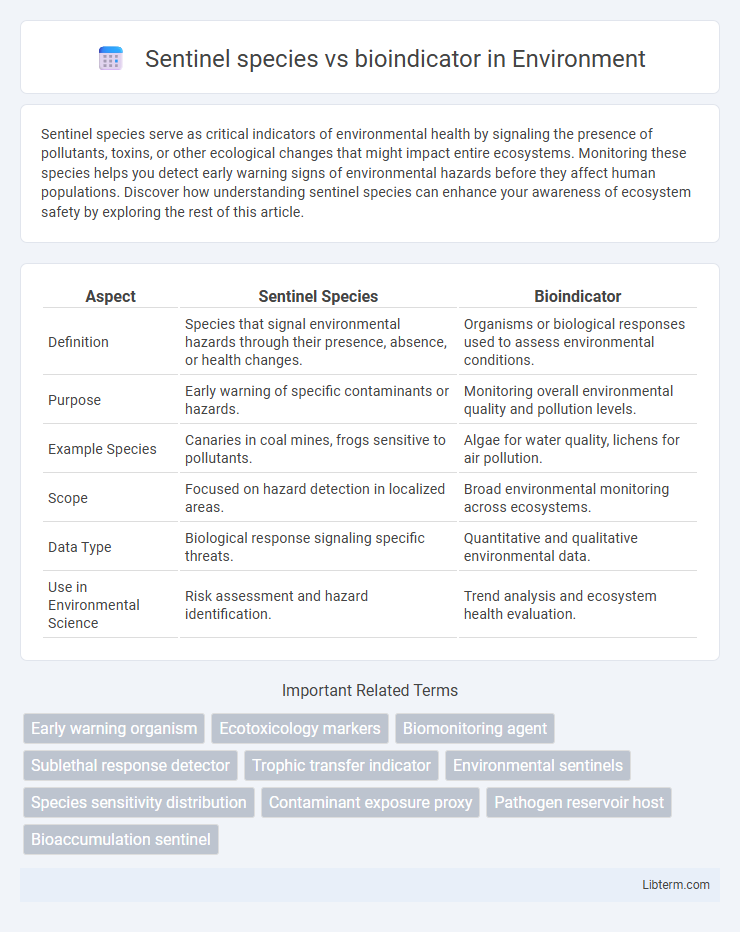Sentinel species serve as critical indicators of environmental health by signaling the presence of pollutants, toxins, or other ecological changes that might impact entire ecosystems. Monitoring these species helps you detect early warning signs of environmental hazards before they affect human populations. Discover how understanding sentinel species can enhance your awareness of ecosystem safety by exploring the rest of this article.
Table of Comparison
| Aspect | Sentinel Species | Bioindicator |
|---|---|---|
| Definition | Species that signal environmental hazards through their presence, absence, or health changes. | Organisms or biological responses used to assess environmental conditions. |
| Purpose | Early warning of specific contaminants or hazards. | Monitoring overall environmental quality and pollution levels. |
| Example Species | Canaries in coal mines, frogs sensitive to pollutants. | Algae for water quality, lichens for air pollution. |
| Scope | Focused on hazard detection in localized areas. | Broad environmental monitoring across ecosystems. |
| Data Type | Biological response signaling specific threats. | Quantitative and qualitative environmental data. |
| Use in Environmental Science | Risk assessment and hazard identification. | Trend analysis and ecosystem health evaluation. |
Introduction to Sentinel Species and Bioindicators
Sentinel species are organisms specifically monitored to provide early warnings about environmental hazards, detecting toxic substances or ecosystem changes before they affect humans. Bioindicators encompass a broader category of species or biological responses used to assess the health and quality of environments, reflecting pollution levels or habitat disruption. Both concepts serve vital roles in environmental monitoring, with sentinel species acting as targeted early warning systems and bioindicators providing comprehensive ecological assessment.
Defining Sentinel Species
Sentinel species are organisms used to detect risks to humans by providing advance warning of environmental hazards, reflecting contaminant levels or ecosystem changes before widespread impact occurs. Unlike general bioindicators, which signal overall environmental health, sentinel species specifically respond to particular pollutants or toxic agents, making them crucial for early detection of harmful exposure. Examples include canaries in coal mines for carbon monoxide detection and amphibians sensitive to water quality changes.
Understanding Bioindicators
Bioindicators are organisms used to assess the health of an ecosystem by measuring changes in their population, behavior, or physiology in response to environmental stressors. Sentinel species, a subset of bioindicators, are specifically monitored for early detection of environmental hazards due to their sensitivity to pollutants or habitat changes. Understanding bioindicators involves recognizing their role in detecting ecological imbalances, monitoring pollution levels, and providing data for environmental management and conservation strategies.
Key Differences Between Sentinel Species and Bioindicators
Sentinel species are organisms used to detect specific environmental hazards, often showing early signs of contamination or pollution, whereas bioindicators broadly assess the health of an ecosystem through changes in species presence or behavior. Sentinel species typically provide targeted, measurable responses to a particular toxicant or pathogen, while bioindicators reflect overall ecosystem integrity by monitoring a wider range of environmental conditions. Key differences include the specificity of sentinel species to particular threats and the broader ecological context considered by bioindicators for environmental assessment.
Roles in Environmental Monitoring
Sentinel species are organisms specifically monitored to detect early signs of environmental hazards by exhibiting measurable responses to contaminants or ecosystem changes. Bioindicators serve as broader ecological gauges, reflecting the overall health of an environment through their presence, abundance, or physiological state. Both play crucial roles in environmental monitoring by providing valuable data on pollution levels, habitat quality, and the effects of anthropogenic activities on biodiversity.
Examples of Sentinel Species
Sentinel species such as canaries in coal mines, frogs in amphibian population studies, and honeybees in pesticide exposure monitoring serve as early warning systems for environmental hazards. These organisms exhibit heightened sensitivity to pollutants and changes in ecosystem health, providing critical data to detect biochemical or ecological disruptions. Unlike general bioindicators, sentinel species are specifically monitored to alert humans to potential toxicity before widespread harm occurs.
Common Bioindicator Organisms
Sentinel species, such as canaries used historically in coal mines, are organisms that provide early warning signals of environmental hazards, while bioindicator organisms like lichens, frogs, and certain fish species reflect long-term ecosystem health through their presence, absence, or condition. Common bioindicator organisms include mosses, which accumulate heavy metals and indicate air quality, and amphibians, whose sensitive skin responds to water pollution and habitat changes. Studying these bioindicator species offers critical data for monitoring pollution levels, ecosystem integrity, and the effects of environmental stressors on biodiversity.
Advantages and Limitations of Sentinel Species
Sentinel species offer the advantage of early warning systems by exhibiting sensitive responses to environmental hazards, allowing for timely detection of pollutants or ecosystem changes. Their limitations include species-specific sensitivity variations and potential confounding factors such as mobility or habitat range that may affect the accuracy of environmental assessments. Unlike general bioindicators, sentinel species provide targeted data but require careful selection to ensure relevance and reliability in diverse ecosystems.
Strengths and Weaknesses of Bioindicators
Bioindicators provide vital insights into ecosystem health by reflecting biological responses to environmental changes, offering a cost-effective and sensitive method for long-term monitoring. Their strength lies in detecting subtle ecological shifts through species-specific reactions, but they may be limited by variability due to species adaptability and the influence of multiple environmental stressors, complicating data interpretation. Unlike sentinel species, bioindicators encompass broader biological community responses, enhancing ecosystem assessment but requiring careful selection and standardized protocols for accurate environmental risk evaluation.
Choosing Between Sentinel Species and Bioindicators in Research
Choosing between sentinel species and bioindicators in research depends on the specific environmental stressors and ecological contexts being studied. Sentinel species are selected for their sensitivity to particular contaminants or pathogens, providing early warning signals of ecosystem health threats. Bioindicators, on the other hand, offer broader assessments of environmental quality by reflecting cumulative effects of multiple stressors on biological communities.
Sentinel species Infographic

 libterm.com
libterm.com